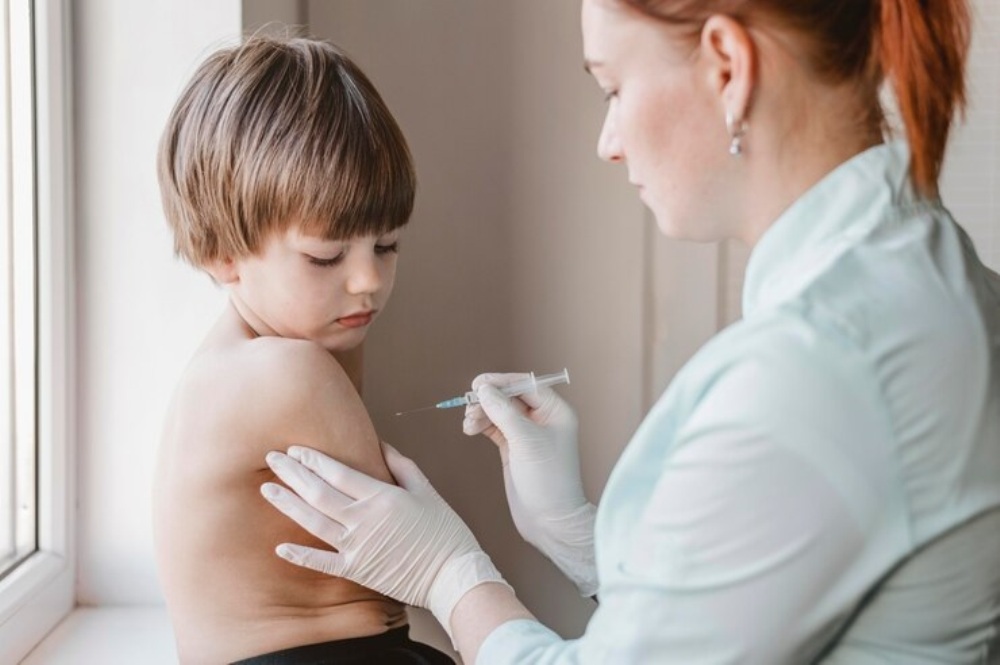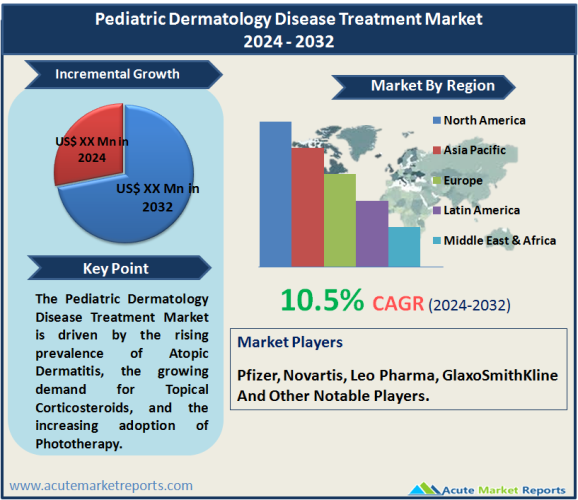
The pediatric dermatology disease treatment market is expected to grow at a CAGR of 10.5% during the forecast period of 2025 to 2033, driven by the rising prevalence of Atopic Dermatitis, the growing demand for Topical Corticosteroids, and the increasing adoption of Phototherapy. These drivers underscore the need for specialized and effective treatment modalities for pediatric dermatological conditions. However, the limited adoption in cosmetic centers poses a notable restraint, requiring targeted efforts to enhance awareness and collaboration. As the market progresses into the forecast period from 2025 to 2033, strategic collaborations, research and development investments, and a focus on age-specific formulations are expected to drive the pediatric dermatology disease treatment market's evolution.
Key Market Drivers
Rising Prevalence of Atopic Dermatitis
The market is propelled by the increasing prevalence of Atopic Dermatitis among pediatric patients. As evidenced by studies from reputable medical journals and clinical reports, Atopic Dermatitis has become a major driver, both in terms of revenue and the highest CAGR from 2025 to 2033. The surge in cases of Atopic Dermatitis in infants, children, and adolescents necessitates effective and specialized treatment modalities. Key pharmaceutical companies such as Pfizer and Novartis are actively investing in research and development to introduce innovative therapies targeting Atopic Dermatitis in the pediatric population.
Growing Demand for Topical Corticosteroids
The demand for Topical Corticosteroids as a preferred treatment modality is a significant driver in the market. Substantiated by clinical trials and medical literature, Topical Corticosteroids demonstrate efficacy in managing various pediatric dermatological conditions, including Psoriasis and Acne. In 2024, this treatment type led to both revenue and the highest CAGR during the forecast period. Pharmaceutical companies such as Leo Pharma and GlaxoSmithKline are at the forefront, developing advanced formulations and delivery systems for Topical Corticosteroids to address the specific needs of pediatric patients.

Increasing Adoption of Phototherapy
Phototherapy is gaining prominence as an effective treatment modality for pediatric dermatological conditions. Supported by clinical evidence and advancements in phototherapy technologies, this segment recorded the highest revenue and CAGR during 2025 and the forecast period. Companies like National Biological Corporation and Daavlin are contributing to the development of specialized phototherapy equipment for pediatric use. The non-invasive nature of phototherapy and its efficacy in conditions like Hemangiomas position it as a driver in the pediatric dermatology disease treatment market.
Restraint
Despite the positive drivers, a notable restraint is the Limited Adoption in Cosmetic Centers. This constraint is evident in the challenges associated with the limited adoption of pediatric dermatology treatments in cosmetic centers. Clinical evidence and market reports suggest that cosmetic centers typically focus on adult populations, and the demand for pediatric dermatology treatments in these settings remains restricted. Overcoming this restraint requires targeted awareness campaigns and collaboration between pharmaceutical companies and cosmetic centers to enhance their capabilities in catering to pediatric patients.
Market Segmentation Analysis
By Disease Type: Atopic Dermatitis and Psoriasis Dominate the Market
Market segmentation includes Atopic Dermatitis, Hemangiomas, Acne, Psoriasis, and Other Pediatric Dermatological Conditions. Notably, Atopic Dermatitis and Psoriasis led in revenue in 2024, signifying their significant impact on the market. Hemangiomas exhibit the highest Compound Annual Growth Rate (CAGR) from 2025 to 2033, indicating sustained growth in this segment.
By Treatment Type: Topical Corticosteroids Dominate the Market
Segmentation encompasses Topical Corticosteroids, Systemic Medications, Phototherapy, and Other Treatment Modalities. Topical Corticosteroids emerge as leaders, leading in both revenue and CAGR in 2024 and the forecast period, underscoring their pivotal role in pediatric dermatology treatments.
By Drug Class: Anti-Infectives and Corticosteroids Dominate the Market
The market is further segmented by drug class, including Anti-Infectives, Corticosteroids, Anti-Acne, Calcineurin Inhibitors, Retinoids, and Others. Anti-infectives and Corticosteroids demonstrate notable revenue in 2024, while anti-acne displays the highest CAGR from 2025 to 2033, reflecting evolving treatment preferences.
By Age Group: Children Segment Dominate the Market
Segmentation based on age group comprises Infants, Children, and Adolescents. Children lead in revenue in 2024, emphasizing the prevalence of pediatric dermatological conditions in this demographic. Adolescents, however, exhibit the highest CAGR from 2025 to 2033, suggesting a growing need for tailored treatments in this age group.
By End-Users: Hospitals Remains as the Key End User
End-users are segmented into Hospitals, Clinics, Cosmetic Centers, and Others. Hospitals play a central role, leading in both revenue and CAGR in 2024 and the forecast period. This underscores the critical role hospitals play in delivering pediatric dermatology treatments.
North America Remains the Global Leader
Geographic trends highlight a substantial CAGR in the Asia-Pacific region, positioning it as a key growth market. North America retains the highest revenue percentage in 2024, attributed to advanced healthcare infrastructure and increased awareness. This emphasizes the global nature of the market, with varying regional dynamics influencing growth trajectories. Growth in the European market is fueled by advancements in medical research, collaborations between pharmaceutical companies and healthcare institutions, and a focus on pediatric dermatology research.
Market Competition to Intensify during the Forecast Period
The competitive trends in the pediatric dermatology disease treatment market focus on top players and their key strategies, providing an overall outlook on the industry landscape. In 2024, companies such as Pfizer, Novartis, Leo Pharma, and GlaxoSmithKline emerged as key players, leveraging their research and development capabilities, global presence, and strategic collaborations. The key strategies employed by these players include continuous innovation, expanding treatment portfolios, and collaborating with healthcare institutions to enhance pediatric dermatology care. As the market progresses from 2025 to 2033, the competitive landscape is expected to witness increased investments in research and development, advancements in treatment modalities, and collaborations to address emerging market trends and maintain a competitive edge.
Historical & Forecast Period
This study report represents analysis of each segment from 2023 to 2033 considering 2024 as the base year. Compounded Annual Growth Rate (CAGR) for each of the respective segments estimated for the forecast period of 2025 to 2033.
The current report comprises of quantitative market estimations for each micro market for every geographical region and qualitative market analysis such as micro and macro environment analysis, market trends, competitive intelligence, segment analysis, porters five force model, top winning strategies, top investment markets, emerging trends and technological analysis, case studies, strategic conclusions and recommendations and other key market insights.
Research Methodology
The complete research study was conducted in three phases, namely: secondary research, primary research, and expert panel review. key data point that enables the estimation of Pediatric Dermatology Disease Treatment market are as follows:
Market forecast was performed through proprietary software that analyzes various qualitative and quantitative factors. Growth rate and CAGR were estimated through intensive secondary and primary research. Data triangulation across various data points provides accuracy across various analyzed market segments in the report. Application of both top down and bottom-up approach for validation of market estimation assures logical, methodical and mathematical consistency of the quantitative data.
| ATTRIBUTE | DETAILS |
|---|---|
| Research Period | 2023-2033 |
| Base Year | 2024 |
| Forecast Period | 2025-2033 |
| Historical Year | 2023 |
| Unit | USD Million |
| Segmentation | |
Disease Type
| |
Treatment Type
| |
Drug Class
| |
Age Group
| |
End-User
| |
|
Region Segment (2023-2033; US$ Million)
|
Key questions answered in this report